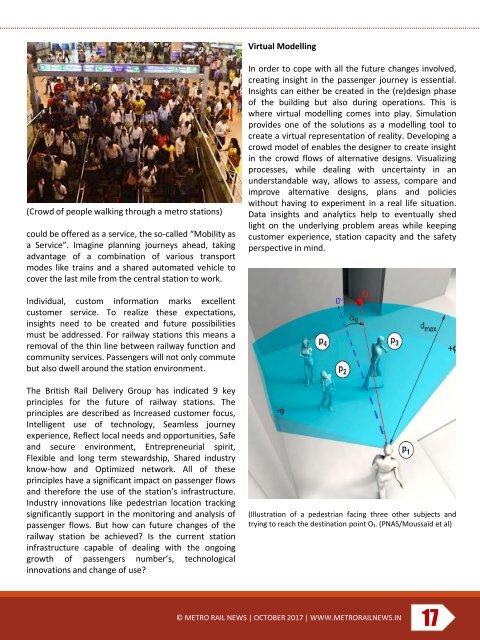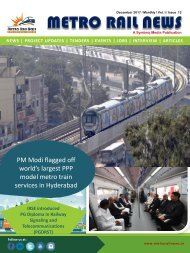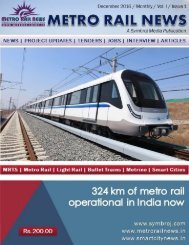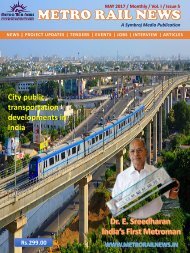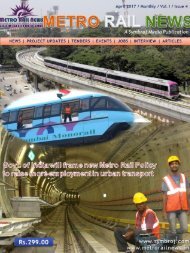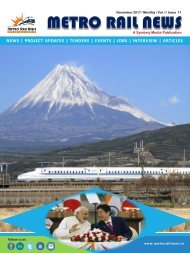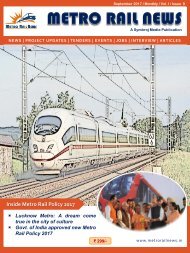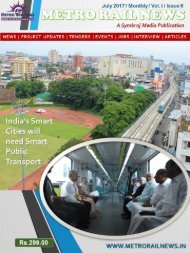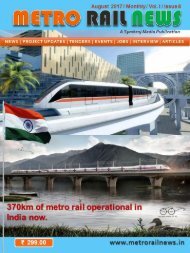Metro Rail News October 2017
October Edition 2017. Owned and published by Symbroj Media Pvt. Ltd., New Delhi, India
October Edition 2017. Owned and published by Symbroj Media Pvt. Ltd., New Delhi, India
You also want an ePaper? Increase the reach of your titles
YUMPU automatically turns print PDFs into web optimized ePapers that Google loves.
Virtual Modelling<br />
(Crowd of people walking through a metro stations)<br />
could be offered as a service, the so-called “Mobility as<br />
a Service”. Imagine planning journeys ahead, taking<br />
advantage of a combination of various transport<br />
modes like trains and a shared automated vehicle to<br />
cover the last mile from the central station to work.<br />
In order to cope with all the future changes involved,<br />
creating insight in the passenger journey is essential.<br />
Insights can either be created in the (re)design phase<br />
of the building but also during operations. This is<br />
where virtual modelling comes into play. Simulation<br />
provides one of the solutions as a modelling tool to<br />
create a virtual representation of reality. Developing a<br />
crowd model of enables the designer to create insight<br />
in the crowd flows of alternative designs. Visualizing<br />
processes, while dealing with uncertainty in an<br />
understandable way, allows to assess, compare and<br />
improve alternative designs, plans and policies<br />
without having to experiment in a real life situation.<br />
Data insights and analytics help to eventually shed<br />
light on the underlying problem areas while keeping<br />
customer experience, station capacity and the safety<br />
perspective in mind.<br />
Individual, custom information marks excellent<br />
customer service. To realize these expectations,<br />
insights need to be created and future possibilities<br />
must be addressed. For railway stations this means a<br />
removal of the thin line between railway function and<br />
community services. Passengers will not only commute<br />
but also dwell around the station environment.<br />
The British <strong>Rail</strong> Delivery Group has indicated 9 key<br />
principles for the future of railway stations. The<br />
principles are described as Increased customer focus,<br />
Intelligent use of technology, Seamless journey<br />
experience, Reflect local needs and opportunities, Safe<br />
and secure environment, Entrepreneurial spirit,<br />
Flexible and long term stewardship, Shared industry<br />
know-how and Optimized network. All of these<br />
principles have a significant impact on passenger flows<br />
and therefore the use of the station’s infrastructure.<br />
Industry innovations like pedestrian location tracking<br />
significantly support in the monitoring and analysis of<br />
passenger flows. But how can future changes of the<br />
railway station be achieved? Is the current station<br />
infrastructure capable of dealing with the ongoing<br />
growth of passengers number’s, technological<br />
innovations and change of use?<br />
(Illustration of a pedestrian facing three other subjects and<br />
trying to reach the destination point O₁. (PNAS/Moussaïd et al)<br />
© METRO RAIL NEWS | OCTOBER <strong>2017</strong> | WWW.METRORAILNEWS.IN<br />
17


